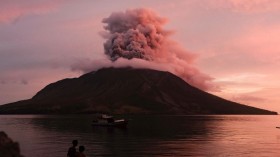Titan is one heck of a mysterious world. As the largest moon orbiting Saturn, this heavenly body plays host to a murky, dense atmosphere and vast seas of methane. These seas even contain "disappearing islands" - strange floating objects that appear and disappear randomly. Another mystery was the origin of its dunes - towering formations that the gentle wind of Titan could not have possibly created. Now, researchers have finally identified the true dune creator.
Back in December, a team of researchers used imagery and data from the Cassini spacecraft - currently orbiting Saturn and its moons - to determine that minimum winds on Titan have to be at least 50 percent faster than most observations have seen in order to move the moon's sand.
That then left researchers scratching their heads, wondering how the heck Titan's towering dunes, which can reach more than 300 feet high and tens-of-miles long, ever existed in the first place. What's more, these dunes change, suggesting something is indeed shifting the moon's sands to build them.
"If the predominant winds are light and blow east to west, then they are not strong enough to move sand," researcher Devon Burr said in a past statement. "But a rare event may cause the winds to reverse momentarily and strengthen."
The events may be so rare and brief, she and her colleagues suggest, that Cassini has simply missed when they occur... until now. (Scroll to read on...)
New computer modeling of Titan's weather systems, based on an ever-mounting pile of data and observations, has revealed that it's possible for methane clouds to reach altitudes of 15.5 miles, where fast eastward winds blow. As a result, rare downdrafts could be created, falling eastward and carving into Titan's surface.
"We were very surprised by the intensity of the storm gusts," Benjamin Charnay, a planetary scientist at the Dynamic Meteorology Laboratory in Paris, recently told Space.com. "For Titan, it is like a hurricane."
But even with these brief 'hurricane' winds, Charnay is quick to add that it would take thousands, if not millions of years for the dunes to amount to the immense heights seen today. However, as the moon is a largely calm world - at least when it comes to atmospheric winds - the idea that the shifted sand would never be pushed back is entirely possible.
The results were recently published in the journal Nature Geoscience and build off past work as seen in Nature last December.
For more great nature science stories and general news, please visit our sister site, Headlines and Global News (HNGN).
- follow Brian on Twitter @BS_ButNoBS.
© 2024 NatureWorldNews.com All rights reserved. Do not reproduce without permission.





